Florabest FAH 18 C3 User Manual [pl, en, de]
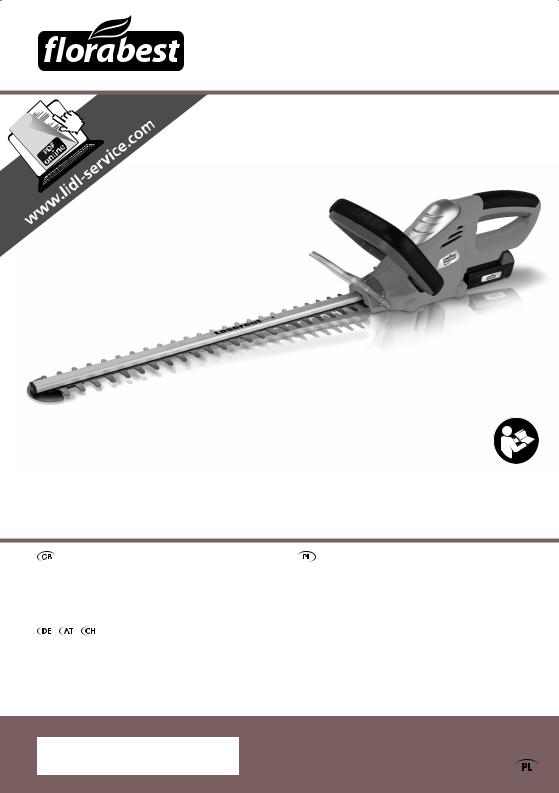
®
CORDLESS HEDGE TRIMMER FAH 18 C3
CORDLESS HEDGE TRIMMER |
AKUMULATOROWE NOŻYCE |
|
DO ŻYWOPŁOTU |
Translation of original operation manual |
|
|
Tłumaczenie oryginalnej instrukcji obsługi |
AKKU-HECKENSCHERE |
|
Originalbetriebsanleitung |
|
IAN 59927

Before reading, unfold the page containing the illustrations and familiarise yourself with all functions of the device.
Przed przeczytaniem proszę rozłożyć stronę z ilustracjami, a następnie proszę zapoznać się z wszystkimi funkcjami urządzenia.
Klappen Sie vor dem Lesen die Seite mit den Abbildungen aus und machen Sie sich anschließend mit allen Funktionen des Gerätes vertraut.
GB |
Translation of original operation manual |
Page |
4 |
PL |
Tłumaczenie oryginalnej instrukcji obsługi |
Strona |
21 |
DE / AT / CH |
Originalbetriebsanleitung |
Seite |
39 |
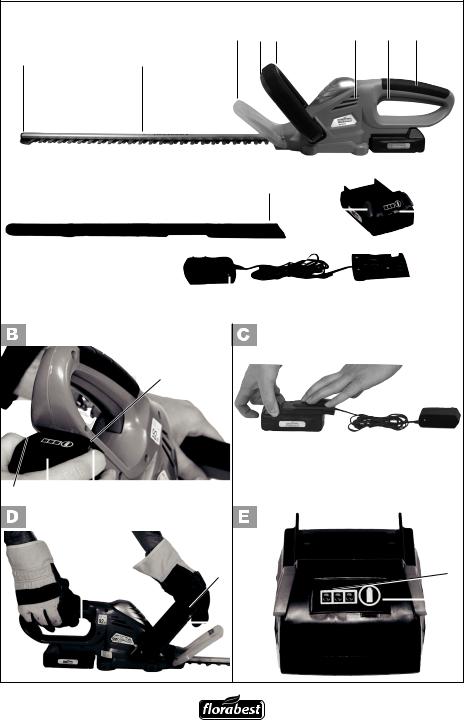
|
|
|
|
|
|
|
3 |
4 |
5 |
6 |
7 |
8 |
|
1 |
2 |
|
|
|
|
|
|
|
|
|
|
|
|
|
|
|
|
|
|
|
|
|
|
9 |
|||||||
13 |
|
13a |
|
|
|
|
|
|
|
|
||||
|
|
|
|
|
10 |
|||||||||
|
|
10 |
|
|
|
|
|
|
||||||
|
|
|
|
|
|
|
||||||||
|
|
|
|
|
|
|
|
|
11 |
|||||
|
|
|
|
|
|
|
|
|
|
|
||||
|
|
|
|
|
|
|
||||||||
|
|
|
|
|
|
|
|
|
|
|
12 |
|||
|
|
|
|
|
|
|
|
|
||||||
|
|
|
|
|
|
|
|
|
|
|
|
|||
|
|
12a |
|
|
|
|
|
|
|
|
||||
|
|
|
|
|
|
|
|
|
|
|
|
|
|
|
14 |
|
|
|
|
|
|
|
|
|
|
|
|
|
|
10 |
|
|
|
|
|
|
|
|
|
|
|
|
|
|
|
|
|
|
|
|
|
|
|
|
|
|
|
|
|
|
|
|
|
|
|
|
|
|
|
|
|
|
|
|
|
|
|
|
|
|
|
|
|
|
|
|
|
|
|
|
|
|
|
9 |
10 |
|
|
9 |
12 |
|
|
||||||||
|
|
|
|
|
|
|
|
|
|
|
|
|
|
|
|
|
|
|
|
7 |
|
|
|
|
|
|
|
|
|
||
|
|
|
|
|
|
5 |
|
|
11 |
||||||
9 |
|
|
|
|
|
|
|
|
4 |
|
|
|
|
|
15 |
|
|
|
|
|
|
|
|
|
|
|
|||||
|
|
|
|
|
|
|
|
|
|
|
|
|
|
||
|
|
|
|
|
|
|
|
|
|
||||||
|
|
|
|
|
|
|
|
|
|
|
|
||||
|
|
|
|
|
|
|
|
|
|
|
|
|
|
|
|
|
|
|
|
|
|
|
|
|
|
|
|
|
|
|
|

GB |
|
Content |
|
Introduction.................................. |
4 |
Intended Use................................ |
5 |
General Description...................... |
5 |
Scope of delivery............................. |
5 |
Function Description.......................... |
5 |
Overview........................................ |
5 |
Technical Data.............................. |
6 |
Notes on Safety............................ |
6 |
Symbols.......................................... |
6 |
General safety instructions for power |
|
tools................................................ |
7 |
Special Safety Directions for the |
|
device........................................... |
10 |
Correct handling of the battery |
|
charger......................................... |
11 |
Charging the battery.................. |
12 |
Removing/inserting the battery......... |
13 |
Recharging the battery.................... |
13 |
Used batteries................................ |
13 |
Operating .................................. |
13 |
Switching On and Off..................... |
14 |
Checking the battery charge level..... |
14 |
Working with the Hedge Trimmer..... |
14 |
Cutting Techniques.......................... |
14 |
Cleaning and Maintenance......... |
15 |
Cleaning....................................... |
15 |
Maintenance.................................. |
15 |
Storage...................................... |
16 |
Waste Disposal and Environ- |
|
mental Protection....................... |
16 |
Spare Parts/Accessories.............. |
17 |
Trouble Shooting........................ |
18 |
Guarantee.................................. |
19 |
Repair Service............................ |
20 |
Service-Center............................ |
20 |
Importer..................................... |
20 |
Translation of the original EC |
|
declaration of conformity............ |
57 |
Exploded Diagram...................... |
59 |
4
Introduction
Congratulations on the purchase of your new device. With it, you have chosen a high quality product. During production, this equipment has been checked for quality and subjected to a final inspection. The functionality of your equipment is therefore guaranteed. It cannot be ruled out that residual quantities of water or lubricants will remain on or in the equipment/hose lines in isolated cases. This is not a fault or defect and it represents no cause for concern.
The operating instructions constitute part of this product. They contain important information on safety, use and disposal.
Before using the product, familiarise yourself with all of the operating and safety instructions. Use the product only as described and for the applications specified. Keep this manual safely and in the event that the product is passed on, hand over all documents to the third party.

Intended Use
The equipment is specified for use only for the cutting and trimming of hedges, bushes and ornamental shrubs in the domestic environment. Any other use that is not explicitly approved in these instructions may result in damage to the equipment and represent a serious danger to the user.
The equipment is designed for use by adults. Adolescents over the age of 16 may use the device only under supervision. Do not use the hedge trimmer in the rain or on wet hedges.
The operator or user is responsible for accidents or damage to other people or their property. The manufacturer is not liable for damages caused by unspecified use or incorrect operation.
Before use, check that the blades are sharp. Ensure that the blades are sharpened whenever blunt, in order to avoid overstressing of the machine. Damages caused by cutting with blunt blades are not covered by the guarantee.
General Description
See the front fold-out page for illustrations.
Scope of delivery
Carefully unpack the trimmer and check that it is complete. Dispose of the packaging material correctly.
-Cordless hedge trimmer
-Knife guard
-Battery
-Battery charger
-Instruction Manual
GB
Function Description
The cordless hedge trimmer features a highquality knife made from special lasercut steel. When trimming, the cutting teeth move to and fro in a linear shearing motion. The strike guard at the tip of the knife prevents unpleasant kickback reactions when hitting walls, fences, etc. Operators are protected by the appliance’s two-hand safety switch and quick-stop brake function. The hand protection guards your hands against twigs and branches. Read the sections below to learn more about each operating element’s function.
Overview
1 Strike guard
2Safety knife bar
3Hand protection
4Safety switch
5Front handle
6Ventilation slots
7On/Off switch
8Rear handle
9Battery
10Battery release buttons
11Battery charge state indicator (LED)
12Battery charger
12a Control indicator charger (LED)
13 Knife guard
13a Suspension knife guard
 14 Guide track
14 Guide track
 15 Button for state of charge display
15 Button for state of charge display
5
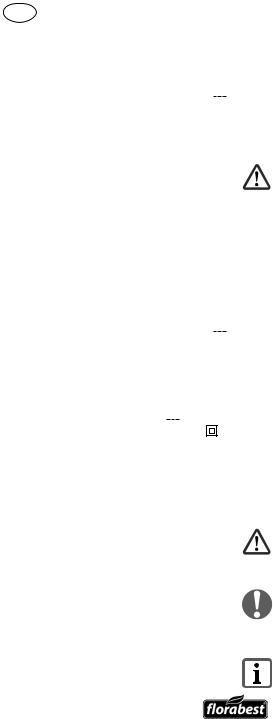
GB
Technical Data
Appliance |
|
|
|
|
|
|
Motor voltage............................. |
|
|
|
18 V |
|
|
|
|
|||||
Idling speed.................... |
|
1300 min-1 (rpm) |
||||
Runtime.............................. |
|
max. 50 min* |
||||
Cutting length...................... |
|
appr. 520 mm |
||||
Max. cutting capacity............ |
appr. 15 mm |
|||||
Weight (with knife guard, |
|
|
|
|
|
|
without battery charger).................. |
|
|
2.7 kg |
|||
Sound pressure level |
|
|
|
|
|
|
(LpA).................. |
77.5 dB(A), KpA=3 dB(A) |
|||||
Sound power level (LwA) |
|
93 dB(A) |
||||
guaranteed............................. |
|
|
||||
measured....... |
91 dB(A); KwA=2.09 dB(A) |
|||||
Vibration (ah)........................................... |
0.970 m/s2, K=1.5 m/s2 |
|||||
Rear handle..... |
||||||
Front handle..... |
1.964 m/s2, K=1.5 m/s2 |
|||||
Battery (Li-Ion) |
|
|
|
|
|
|
Nominal voltage.......................... |
|
|
18 V |
|
|
|
|
||||||
Capacity...................................... |
|
|
|
1.3 Ah |
||
Charging time........................ |
|
approx. 5 h |
||||
Recharger........................ |
|
JLH082100350G |
||||
Nominal consumption...................... |
|
|
12 W |
|||
Voltage input.... |
100-240 V~, 50Hz/60 Hz |
|||||
Voltage output................. |
|
21 V |
|
350 mA |
||
|
|
|||||
Protection class.................................. |
|
|
|
|
II |
|
Protection category............................ |
|
|
IPX0 |
|||
* The actual runtime under load of a fully charged battery depends on how you work and on the load put on the trimmer during operation.
Noise and vibration values have been determined according to the standards and regulations mentioned in the declaration of conformity.
Technical and optical changes may be undertaken in the course of further development without notice. All dimensions, references and information in this instruction manual are therefore not guaranteed. Legal claims made on the basis of the instruction manual can therefore not be considered as valid.
6
The stated vibration emission value was measured in accordance with a standard testing procedure and may be used to compare one power tool to another.
The stated vibration emission value may also be used for a preliminary exposure assessment.
Warning:
The vibration emission value may differ during actual use of the power tool from the stated value depending on the manner in which the power tool is used.
Safety precautions aimed at protecting the user should be based on estimated exposure under actual usage conditions (all parts of the operating cycle are to be considered, including, for example, times during which the power tool is turned off and times when the tool is turned on but is running idle).
Notes on Safety
This section details the basic safety instructions for working with the appliance.
Symbols
Symbols in the manual
Warning symbols with information on damage and injury prevention.
Instruction symbols (the instruction is explained at the place of the exclamation mark) with information on preventing damage.
Help symbols with information on improving tool handling.
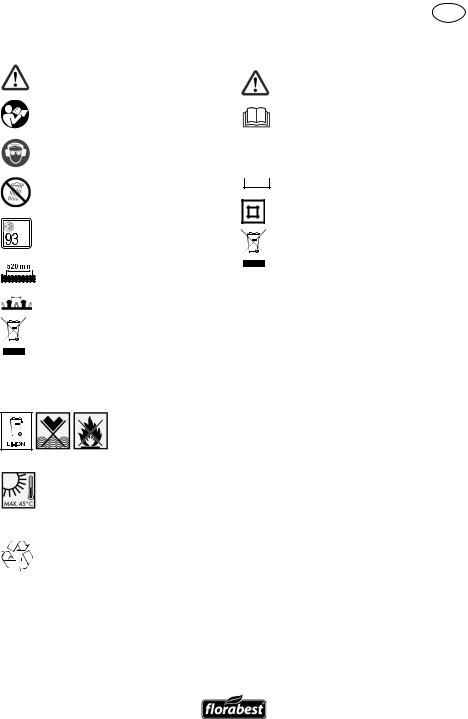
Symbols on the Equipment
|
Caution! |
|
Read through the instruction manual |
|
carefully. |
|
Wear eye and ear protection. |
|
Do not use the hedge trimmer in the |
|
rain or on wet hedges. |
LWA Information of the acoustic power |
|
dB |
level LWA in dB. |
|
Cutting length |
15 mm |
Cutting capacity |
|
Electrical appliances must not be |
|
disposed of with the domestic |
|
waste. |
Symbols on the battery
Do not dispose of batteries in household waste, fire or water.
Do not subject the battery to strong sunlight over long periods and
do not leave it on a heater (max. 45°C).
Take batteries to an old battery collection point where they will be recycled in an environmentally friendly manner.
GB
Symbols on the recharger
WARNING!
Before using for the first time, carefully read through the user manual
 The recharger is for indoor use only.
The recharger is for indoor use only.  Protective temperature limiter
Protective temperature limiter
Protection class II
Electrical appliances must not be disposed of with the domestic waste.
General safety instructions for power tools
WARNING! Read all safety directions and instructions.
Omissions in the compliance with safety directions and instructions can cause electrical shock, fire and/or severe injuries.
Retain all safety directions and instructions for future use.
The term „power tool“ in the warnings refers to your mains-operated (corded) power tool or battery-operated (cordless) power tool.
1) Work area safety
•Keep work area clean and well lit. Cluttered or dark areas invite accidents.
•Do not operate power tools in explosive atmospheres, such as in the presence of flammable
Iiquids, gases or dust. Power tools
7

GB
create sparks which may ignite the dust or fumes.
•Keep children and bystanders away while operating a power tool. Distractions can cause you to lose control.
2) Electrical safety
•Power tool plugs must match the outlet. Never modify the plug in any way. Do not use any adapter plugs with earthed (grounded) power tools. Unmodified plugs and matching outlets will reduce risk of electric shock.
•Avoid body contact with earthed or grounded surfaces, such as pipes, radiators, ranges and refrigerators. There is an increased risk of electric shock if your body is earthed or grounded.
•Do not expose power tools to rain or wet conditions. Water entering a power tool will increase the risk of electric shock.
•Do not abuse the cord. Never use the cord for carrying, pulling or unplugging the power tool. Keep cord away from heat, oil, sharp edges or moving parts. Damaged or entangled cords increase the risk of electric shock.
•When operating a power tool outdoors, use an extension cord suitable for outdoor use. Use of a cord suitable for outdoor use reduces the risk of electric shock.
•If operating a power tool in a damp location is unavoidable, use a residual current device (RCD) protected supply. Use of an RCD reduces the risk of electric shock.
8
3) Personal safety
•Stay alert, watch what you are doing and use common sense when operating a power tool. Do not use a power tool while you are tired or under the influence of drugs, alcohol or medication. A moment of inattention white operating power tools may result in serious personal injury.
•Use personal protective equipment. Always wear eye protection. Protective equipment such as dust mask, non-skid safety shoes, hard hat, or hearing protection used for appropriate conditions will reduce personal injuries.
•Prevent unintentional starting. Ensure the switch is in the offposition before connecting to power source and/or battery pack, picking up or carrying the tool. Carrying power tools with your finger on the switch or energising power tools that have the switch on invites accidents.
•Remove any adjusting key or wrench before turning the power tool on. A wrench or a key left attached to a rotating part of the power tool may result in personal injury.
•Do not overreach. Keep proper footing and balance at all times.
This enables better control of the power tool in unexpected situations.
•Dress properly. Do not wear loose clothing or jewellery. Keep your hair, clothing and gloves away from moving parts. Loose clothes, jewellery or long hair can be caught in moving parts.
•If devices are provided for the connection of dust extraction

and collection facilities, ensure these are connected and properly used. Use of dust collection can
reduce dust-related hazards.
4) Power tool use and care
•Do not force the power tool. Use the correct power tool for your application. The correct power tool will do the job better and safer at the rate for which it was designed.
•Do not use the power tool if the switch does not turn it on and off. Any power tool that cannot be controlled with the switch is dangerous and must be repaired.
•Disconnect the plug from the power source and/or the battery pack from the power tool before making any adjust -ments, changing accessories, or storing power tools. Such preventive safety measures reduce the risk of starting the power tool accidentaIly.
•Store idle power tools out of the reach of children and do not allow persons unfamiliar with the power tool or these instructions to operate the power tool. Power tools are dangerous in the hands of untrained users.
•Maintain power tools. Check for misalignment or binding of moving parts, breakage of parts and any other condition that may affect the power tool’s operation. If damaged, have the power tool repaired before use. Many accidents are caused by poorly maintained power tools.
•Keep cutting tools sharp and clean. Properly maintained cutting tools with sharp cutting edges are less
GB
Iikely to bind and are easier to control.
•Use the power tool, accessories and tool bits etc. in accordance with these instructions, taking into account the working conditions and the work to be
performed. Use of the power tool for operations different from those intended could result in a hazardous situation.
5)CAREFUL HANDLING AND USE OF BATTERY DEVICES
•Charge the batteries only in chargers that are recommended by the manufacturer. Risk of fire if a charger that is suitable for a specific type of battery is used with other batteries.
•In the power tools, use only the batteries designed for the purpose. The use of other batteries may result in injuries and risk of fire.
•Keep the unused battery away from paper clips, coins, keys, nails, screws and other small metal objects, which could cause bridging of the contacts. A short circuit between the battery contacts may cause burns or fire.
•If used incorrectly, liquid may leak from the battery. Avoid contact with this. In the event of accidental contact, rinse off with water. If the liquid gets into eyes, seek medical assistance. Leaking battery fluid may cause skin irritations or burns.
6) Service
•Have your power tool serviced by a qualified repair person using only identical replacement parts. This will ensure that the safety of the power tool is maintained.
9

GB
Special Safety Directions for the device
1)Special safety directions for hedge trimmers
•Keep all parts of the body away from the cutter blade. Do not remove cut material or hold material to be cut when blades are moving. Make sure the switch is off when clearing jammed material. A moment of inattention while operating the hedge trimmer may result in serious personal injury.
•Carry the hedge trimmer by the handle with the cutter blade stopped. When transporting or storing the hedge trimmer always fit the cutting device cover.
Proper handling of the hedge trimmer will reduce possible personal injury from the cutter blades.
•Hold the power tool only on the insulated handle surfaces, as the cutting blade may come into contact with concealed power cables. Contact between the cutting blade and a live cable may render metallic components live and result in an electric shock.
•Keep cable away from cutting area. During operation the cable may be hidden in shrubs and can be accidentally cut by the blade.
•Before the work, search the hedge for concealed objects, e.g. cable etc. In this way you avoid damage to the appliance
•Hold the hedge trimmer correctly, e.g. with both hands on the handles, if there are two handles. Loss of control of the equip-
10
ment may result in injuries.
•Wear suitable clothing and work clothes when working with the equipment. Do not hold the equipment by the cutting blade or lift it on the cutting blade. Contact with the cutting blade can cause injuries.
2) Further safety directions
For your personal safety:
Wear suitable work clothes such as boots with non-slip soles, sturdy long trousers, gloves and goggles.
Do not wear long flowing clothing or jewellery, as this may be caught by moving parts. Do not use this tool while walking barefooted or while wearing open sandals.
•The appliance is designed for trimming hedges. Do not use to cut twigs, hard wood or other objects. This could damage the appliance.
•Do not attempt to dislodge a blocked/trapped blade before switching the tool off. There is a risk of injury.
•When operating the appliance, always hold it well with both hands and at some distance away from your body. This enables better control of the power tool in unexpected situations.
•Do not use the tool in the vicinity of flammable liquids or gasses.
Fireand explosion risk exist in the event of a short circuit.
•The blades have to be checked for wear in regular intervals and re-sharpened. Blunt blades will

overload the machine. Resulting damages are not covered by warranty.
•Do not attempt to repair the tool yourself, unless you are schooled in this field. All works, which are not described in this manual, may only be performed by our Service-Centre. Many accidents are caused by poorly maintained equipment.
3)Special safety directions for battery-operated tools
•Ensure that the device is switched off before inserting the battery. Inserting a battery into a power tool that is switched on may result in accidents.
•Recharge the batteries indoors only because the battery charger is designed for indoor use only. Risk of electric shock.
•To reduce the electric shock hazard, unplug the battery charger from the mains before cleaning the charger.
•Do not subject the battery to strong sunlight over long periods and do not leave it on a heater. Heat damages the battery and there is a risk of explosion.
•Allow a hot battery to cool before charging.
•Do not open up the battery and avoid mechanical damage to the battery. Risk of short circuit and fumes may be emitted that irritate the respiratory tract. Ensure fresh air and seek medical assistance in the event of discomfort.
•Do not use non-rechargeable batteries. This could damage the appliance.
GB
4) RESIDUAL RISKS
Even if properly operating and handling this electric tool, some residual risks will remain. Due to its construction and build, this electric tool may present the following hazards:
a)Cuts
b)Ear damage if working without ear protection.
c)Damage to your health caused by swinging your hands and arms when operating the appliance for longer periods of time or if the unit is not held or maintained properly.
Warning! During operation, this electric tool generates an electromagnetic field which, under certain circumstances, may impair the functionality of active or passive medical implants. To reduce the risk of serious or lethal injuries, we recommend that persons with medical implants consult their doctor and the manufacturer of their medical implant before operating the machine.
Correct handling of the battery charger
•This appliance is not intended for use by persons (including children) with reduced physical, sensory or mental capabilities, or lack of experience and knowledge, unless they have been given supervision or instruction concerning use of the appliance by a person responsible for their safety.
•Children should be supervised to ensure that they do not play with the appliance.
•To charge the battery, use only the charger supplied. Risk of fire
11

GB
and explosion. This ensures that the safety of the device is maintained.
•Before each use, check the charger, cable and plug and have them repaired by qualified professionals and only with original parts. Do not use a defective charger and do not open it up yourself. This ensures that the safety of the device is maintained.
•Connect the charger only to a socket with an earth. Ensure that the mains voltage matches the specifications on the charger rating plate. Risk of electric shock.
•Disconnect the charger from the mains before closing or opening connection to the battery / power tool / device. This ensures that the battery and charger are not damaged.
•Keep the charger clean and away from wet and rain. Do not use the charger outdoors. Dirt and the entry of water increase the risk of electric shock.
•Operate the charger only with the appropriate original batteries. Charging other batteries may result in injuries and risk of fire.
•Avoid mechanical damage to the charger. This can result in internal short circuits.
•Do not operate the charger on a combustible surface (e.g. paper, textiles). Risk of fire due to heating during charging.
•If the power cable for this equipment is damaged, it must be replaced by the manufacturer, a customer service agent of the same or a similarly qualified person in order to prevent hazards.
•The battery of the appliance is not fully charged at the time of delivery. It there-
12
fore needs to be fully recharged before you use it for the first time. For the first recharge cycle we recommend that you charge the battery for about 1 hour. Slot the battery into the base and plug the battery charger into a mains outlet.
•When the battery is fully charged, unplug the charger from the mains and from the appliance. Charging time is approx. 5 hour.
•Do not charge the battery continuously. Repeatedly charging small capacities may damage the battery cells.
Charging the battery
Do not expose the battery to extreme conditions such as heat or impact. Risk of injury from escaping electrolytic solution! After eye/skin contact, rinse the affected areas with water or a neutraliser and consult a doctor.
Charge the battery in a dry room only. Prior to attaching the charger, check that the battery’s outer surface is clean and dry. There is a risk of injury due to electric shock.
Only use the charger from the package to charge the battery. Mind not to charge the appliance for more than 5 hours at a time. If you do, the battery and the appliance may be damaged and longer charging times would be a waste of energy. Excessive charging will void the warranty.
•Charge the battery before the first time of use. Do not briefly charge the bat-
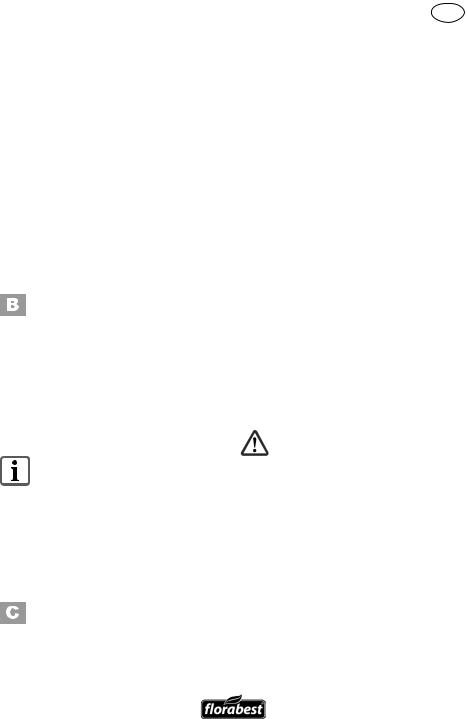
tery several time in a row.
•If a fully recharged battery lasts for considerably shorter operating times, the battery is used up and needs to be replaced. Only use an OEM spare battery available from our Customer Service.
•Always take heed of the applicable safety instructions as well as the environmental protection regulations and information.
•The warranty excludes all defects caused by improper handling.
Removing/inserting the battery
1.To remove the battery (9) from the appliance, press the release button (10) on the battery and pull out the battery.
2.To insert the battery (9), place it on the guide track (14) and push it back into the appliance. It will audibly snap in.
Recharging the battery
Recharge the battery when the last charge state indicator LED ( 11) changes from green to red.
11) changes from green to red.
When starting to charge and while charging, the control indicator
( 12a) of the battery charger (12) lights up red.
12a) of the battery charger (12) lights up red.
When charging is over, the control indicator changes to green.
1.Remove the battery (9) from the appliance, as necessary.
2.Insert the battery (9) in the charging compartment of the battery charger (12). It will audibly snap
GB
in.
3.Plug the battery charger (12) into a mains outlet.
4.When the battery is fully recharged unplug the battery charger (12) from the mains.
5.Press the release button ( 10) on the battery (9) and pull the battery out of the battery charger (12).
10) on the battery (9) and pull the battery out of the battery charger (12).
Used batteries
•If a fully recharged battery lasts for considerably shorter operating times, the battery is used up and needs to be replaced. Only use an OEM battery pack replacement available from our Customer Service.
•Always take heed of the applicable safety instructions as well as the environmental protection regulations and information (see “Waste Disposal and Environmental Protection”).
Operating
Wear suitable clothing and work gloves when working with the equipment.
Ensure that the equipment is functional before each use. The On/Off switch and the safety switch must not be held closed. They must switch off the motor when on is released. Should a switch be damaged, stop working with the equipment. Ensure that the mains voltage value matches the label on the equipment. Reduce the risk of injuries and accidents by wearing personal protection equipment and ensuring that the unit is fully functional.
13

GB
After turning off the appliance, the blades will keep moving for some time. Allow the blades to come to a standstill. Neither touch nor slow down the moving blades. Risk of injury!
Note noise protection and local specifications.
Switching On and Off
Ensure that you are standing in a firm position with both hands gripping the hedge trimmer away from the body. Ensure that the trimmer is in contact with no other objects before switching on.
Turning on:
1.Before turning on the unit, remove the knife guard ( 13).
13).
2.Check that the battery (9) is in (see “Removing/inserting the battery”).
3.Press the safety switch (4) at the front handle (5).
4.Press the On/Off switch (7). The hedge trimmer will run at top
speed.
Turning off:
5.Release the safety switch (4) or the On/Off switch s (7).
Checking the battery charge level
The battery’s (9) charge level is indicated by the charge state indicator (11).
14
Press the button for state of charge display (15) on the battery (9). The LEDs indicate the battery’s charge level.
Recharge the battery when the last charge state indicator LED ( 11) changes from green to red.
11) changes from green to red.
Working with the Hedge Trimmer
During cutting work, ensure that no contact is made with objects, e.g. such as wire fencing or main plant stems. This may result in damage to the cutter bar.
•Switch off the equipment immediately in the event that the blades are blocked by solid objects, pull out the power plug then remove the object.
•Avoid overstraining the equipment during work.
Cutting Techniques
•Cut thick branches beforehand using a branch clippers.
•The double-sided cutter bar enables cutting in both directions or, with a swinging action, from one side to the other.
•In case of vertical cutting, move the hedge trimmer uniformly forward or up and down in an arc movement.
•In case of horizontal cutting, move the hedge trimmer in a sickle-shaped movement to the edge of the hedge, so that cut branches fall to the ground.
•In order to achieve long straight lines, the placing of tensioned guiding cords is recommended.
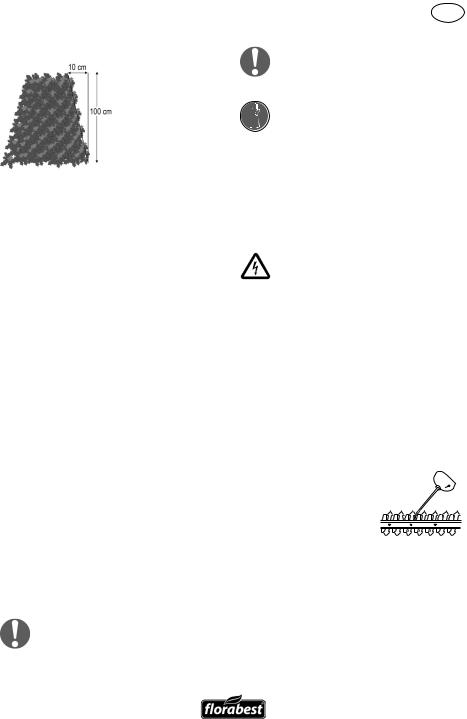
Cutting Shaped Hedges:
It is recommended that hedges be cut in a trapezoidal shape, in order to prevent stripping off of the lower branches. This corresponds to the natural plant
growth and allows the hedge to thrive optimally. During cutting, only the new annual growths are reduced and thus a dense branching and a good screen will develop.
•Cut the sides of a hedge first. To do this, move the hedge trimmer in the direction of growth from bottom to top. If you cut down from the top, the thinner branches will move out, which
may result in some areas having sparse growth or holes.
•Cut the top edge, according to taste, in a flat shape, roof shape or rounded shape
•Trim young plants to the required shape. The main growth should remain undamaged until the hedge has reached the planned height. All other shoots are lopped off to half size.
Care of Free-Growing Hedges:
Free-growing hedges are not shaped when cut, although they must be regularly maintained so the hedge does not become too high.
Cleaning and
Maintenance
Repair and servicing work not described in this manual should always be carried by our Service Centre. Use only original parts.
GB
Turn off the appliance and, before doing any servicing, remove the battery.
Wear gloves when handling the safety knife bar. This will protect you against cuts.
The following cleaning and servicing should be done regularly. This will ensure a long and reliable service life.
Cleaning
Do not spray the appliance with water and do not immerse it in water. Electric shock hazard!
•Keep clean the ventilation slots, motor housing and handles of the appliance. Use a damp cloth or a brush.
Do not use cleaning agents or solvents. You may otherwise irreparably damage the appliance.
•Always keep the equipment clean. After using the equipment, it is imperative to:
-Clean the blade (with an oily cloth);
-Oil the blade shaft
with an oil can or spray.
Maintenance
•Prior to every use, check the appliance for obvious defects such as loose, worn or damaged parts. Check that the
screws in the safety knife bar ( 2) are tight.
2) are tight.
•Check covers and safety devices (see
 ) for damages and correct installation. Replace as necessary.
) for damages and correct installation. Replace as necessary.
15

GB
•You can smoothen minor nudges in the cutting teeth yourself using a knife grinder to sharpen the cutting edges. The trimmer will only cut well if the teeth are sharp.
•Blunt, bent or damaged knife bars to be replaced.
Storage
•Keep the device in the knife guard
(  15) supplied, dry and out of reach of children.
15) supplied, dry and out of reach of children.
•The device can be suspended onto the suspension devices on the knife guard (  13).
13).
•Remove the battery before storing the unit for longer periods of time (e.g. hibernation).
•Store the battery only in a partially charged state. The state of charge should be 40 – 60 % over a longer storage period.
•During a longer storage period, check the state of charge of the battery and recharge if necessary roughly every
3 months.
•In order to keep the battery well charged, avoid exposing the appliance to extreme heat or cold in storage.
•Store the equipment between 10° C and 25° C. During storage, avoid extreme cold or heat so the battery does not lose power.
Waste Disposal and Environmental Protection
Remove the battery from the device and take the device, battery, accessories and packaging for environmentally friendly recycling.
Machines do not belong with domestic waste.
Do not dispose of batteries in household waste, fire (risk of explosion) or water. Damaged batteries may damage the environment and your health if toxic fumes or liquids leak out.
•Return the unit to a recycling centre.
•Dispose of batteries in discharged condition. We recommend covering the pole with adhesive tape to prevent a short circuit. Do not open up the battery.
•Dispose of batteries in accordance with the local regulations. Take batteries to an old battery collection point where they will be recycled in an environmentally friendly manner. For information about this, ask your local waste management company or our service centre.
•Throw the cut grass on the compost. Do not throw it in the normal household waste.
16

GB
Spare Parts/Accessories
Spare parts and accessories can be obtained at
www.grizzly-service.eu
If you do not have internet access, please contact the Service Centre via telephone (see “Sercice-Center” Page 20). Please have the order number mentioned below ready.
Position |
Position |
Description |
Order No. |
||
instruction |
exploded |
|
|
||
manual |
drawing |
|
|
||
|
|
3 |
SET 11 |
Hand protection |
91100556 |
|
|||||
|
|
|
|
|
|
|
|
4+5 |
SET 35 |
Front handle |
91100557 |
|
|||||
|
|
|
|
|
|
|
|
9 |
SET 34 |
Battery 18 V |
91100553 |
|
|||||
|
|
|
|
|
|
|
|
12 |
SET 33 |
Battery charger |
91100552 |
|
|||||
|
|
|
|
|
|
|
|
13 |
SET 25 |
Knife guard |
91100544 |
|
|||||
|
|
|
|
|
|
17

GB
Trouble Shooting
Problem |
Possible cause |
|
|
Corrective action |
|
|
|||||||||||
|
|
|
|
|
|
|
|
|
|
|
|
|
|
|
|
||
|
Battery ( |
|
|
9) discharged |
Recharge battery (see „Charging“) |
||||||||||||
|
|
|
|||||||||||||||
|
|
|
|
|
|
|
|
|
|
|
|
|
|
|
|
|
|
Appliance |
Battery ( |
|
|
9) not inserted |
Insert battery (see „Operation“) |
||||||||||||
|
|
||||||||||||||||
|
|
|
|
|
|
|
|
|
|
|
|
|
|
|
|
|
|
Safety switch ( |
|
|
|
4) not |
Turn on (see "Operation") |
||||||||||||
|
|
||||||||||||||||
won‘t start |
pressed properly |
|
|
|
|
|
|||||||||||
|
|
|
|
|
|
|
|
|
|
|
|
|
|
|
|
|
|
|
On/Off switch ( |
|
|
7) defec- |
Send in to Service Centre for repair |
||||||||||||
|
|
|
|||||||||||||||
|
tive |
|
|
|
|
|
|
|
|
|
|
|
|
|
|||
|
|
|
|
|
|
|
|
|
|
|
|
|
|
|
|
|
|
Intermittent op- |
Internal loose contact |
|
|
|
|
|
|||||||||||
|
|
|
|
|
|
|
|
|
|
|
|
Send in to Service Centre for repair |
|||||
On/Off switch ( |
|
|
|
7) defec- |
|||||||||||||
eration |
|
|
|||||||||||||||
|
tive |
|
|
|
|
|
|
|
|
|
|
|
|
|
|||
|
Blades ( |
|
|
|
2) are blunt |
Have the blades sharpened or re- |
|||||||||||
|
|
|
|
||||||||||||||
|
|
|
placed (Service Centre) |
||||||||||||||
|
|
|
|
|
|
|
|
|
|
|
|
|
|||||
|
|
|
|
|
|
|
|
|
|
|
|
|
|
|
|
|
|
Blades become |
Blades ( |
|
|
|
2) are notched |
Have the blades checked or replaced |
|||||||||||
hot |
|
|
(Service Centre) |
|
|
||||||||||||
|
|
|
|
|
|
|
|
|
|
|
|
|
|
||||
|
|
|
|
|
|
|
|
|
|
|
|
|
|
|
|
|
|
|
Too much friction due to |
Oil the knife bar ( |
|
|
2) |
||||||||||||
|
lack of lubrication |
|
|
||||||||||||||
|
|
|
|
|
|
||||||||||||
|
|
|
|
|
|
|
|
|
|
|
|
|
|
|
|
|
|
|
Too much friction due to |
Lubricate knife bar ( |
|
|
2) |
||||||||||||
|
missing lubrication |
|
|
||||||||||||||
|
|
|
|
|
|
||||||||||||
|
|
|
|
|
|
|
|
|
|
|
|
|
|
|
|
|
|
|
Knife bar ( |
|
|
2) dirty |
Clean knife bar |
|
|
||||||||||
|
|
|
|
|
|||||||||||||
|
|
|
|
|
|
|
|
|
|
|
|
|
|
|
|
|
|
|
Knife bar ( |
|
|
2) blunt |
Grind or have knife bar replaced |
||||||||||||
Bad trim |
|
|
(Service Centre) |
|
|
||||||||||||
|
|
|
|
|
|
|
|
|
|
|
|
|
|
||||
|
|
|
|
|
|
|
|
|
|
|
|
|
|
|
|
|
|
|
Bad cutting technique |
See ("Working with the hedge trim- |
|||||||||||||||
|
mer") |
|
|
||||||||||||||
|
|
|
|
|
|
|
|
|
|
|
|
|
|
|
|||
|
Battery ( |
|
|
9) not fully |
Recharge battery (see "Charging") |
||||||||||||
|
|
|
|||||||||||||||
|
charged |
|
|
|
|
|
|
|
|
||||||||
|
|
|
|
|
|
|
|
|
|
|
|
|
|
||||
18

Guarantee
Dear Customer,
This equipment is provided with a 3-year guarantee from the date of purchase.
In case of defects, you have statutory rights against the seller of the product. These statutory rights are not restricted by our guarantee presented below.
Terms of Guarantee
The term of the guarantee begins on the date of purchase. Please retain the original receipt. This document is required as proof of purchase.
If a material or manufacturing defect occurs within three years of the date of purchase of this product, we will repair or replace – at our choice – the product for you free of charge. This guarantee requires the defective equipment and proof of purchase to be presented within the three-year period with a brief written description of what constitutes the defect and when it occurred.
If the defect is covered by our guarantee, you will receive either the repaired product or a new product. No new guarantee period begins on repair or replacement of the product.
Guarantee Period and Statutory Claims for Defects
The guarantee period is not extended by the guarantee service. This also applies for replaced or repaired parts. Any damages and defects already present at the time of purchase must be reported immediately after unpacking. Repairs arising after expiry of the guarantee period are chargeable.
Guarantee Cover
The equipment has been carefully produced in accordance with strict quality guidelines and conscientiously checked prior to delivery.
GB
The guarantee applies for all material and manufacturing defects. This guarantee does not extend to cover product parts that are subject to normal wear and may therefore be considered as wearing parts (e.g. knives, battery and gear wheel) or to cover damage to breakable parts (e.g. switches, batteries).
This guarantee shall be invalid if the product has been damaged, used incorrectly or not maintained. Precise adherence to all of the instructions specified in the operating manual is required for proper use of the product. Intended uses and actions against which the operating manual advises or warns must be categorically avoided.
The product is designed only for private and not commercial use. The guarantee will be invalidated in case of misuse or improper handling, use of force, or interventions not undertaken by our authorised service branch.
Processing in Case of Guarantee
To ensure quick handling of you issue, please follow the following directions:
•Please have the receipt and identification number (IAN 59927) ready as proof of purchase for all enquiries.
•Please find the item number on the rating plate.
•Should functional errors or other defects occur, please initially contact the
service department specified below by telephone or by e-mail. You will then receive further information on the processing of your complaint.
•After consultation with our customer service, a product recorded as defective can be sent postage paid to the service address communicated to you, with the proof of purchase (receipt) and specification of what constitutes the defect and when it occurred. In order to avoid
19
